- Recent Updates
- Colpoy's Bay
- Colpoy's Bay Introduction
- Spragge's Hill
- The Kalbfleisch House
- The Kalbfleisch Dock
- The Kalbfleisch Marina
- Whicher's Sawmill
- The Wrecks Near Whicher's Mill
- Frame's Falls and John Wood's Grist Mill
- Albemarle Street
- Hughenden and Whicher's Store
- The Community Hall
- The Forest Home Hotel
- The Colpoy's Bay Schoolhouse
- The Colpoy's Bay Church
- Edgehill Cemetery
- Colpoy's Bay From the Air
- A Glimpse of the Past
- Wiarton
- Berford Street
- Berford St. Part 2
- Berford St. Part 3
- Wiarton Harbour
- Bluewater Beach
- Caframo Ltd. and Wiarton Cement Works
- Wiarton Beet Sugar Factory
- Wiarton's Hotels
- Wiarton's Schools
- Wiarton's Banks
- Grand Trunk Railway Station
- The Wiarton Fish House
- The Wiarton Fish Hatchery
- Wiarton's Berford Theatre
- The Wiarton Woolen Mills
- Wiarton's Furniture Industry
- Wiarton's Hospital
- Wiarton's War Memorial
- Wiarton's Town Hall
- Wiarton's Newspapers
- Wiarton's Grist & Flour Mills
- Wiarton's Sawmill Industry
- Wiarton's Gateway
- Connecting Passages
(Links) - Present-day Map
of Colpoy's Bay - Colpoy's Bay
Lot Map (1870) 
Wiarton Timeline- Present-day Map
of Wiarton - Bibliography
- About the Author
- Site Map
(use if menu doesn't work) - Tell me your impressions!
The Wiarton Fish Hatchery
For 85 years the north shore of Colpoy's Bay was graced by the picturesque federal government fish hatchery. Looking much like one of the old frame-structure hotels, this two and a half storey white building long marked the most northeasterly shoreside landmark in Wiarton, set quaintly beneath the towering limestone cliffs, not far from the legendary outcrop called Spirit Rock where a native maiden is said to have jumped to her death after the demise of her beloved husband.
The drive for a fish hatchery in Wiarton began as early as April 1891 when a representative visited the town to study its suitability. Three years later the Wiarton Echo newspaper published editorials lobbying for a fish hatchery in Wiarton.
However, it was not until 1906 that Wiarton was awarded a federal hatchery, beating out the rival (and often much larger) towns and cities of Goderich, Southampton, Owen Sound, Meaford, Collingwood and Parry Sound. Construction was completed in September of 1907, coming in at just over half of the budgeted cost of $6500 (over $137 000 in today's funds).
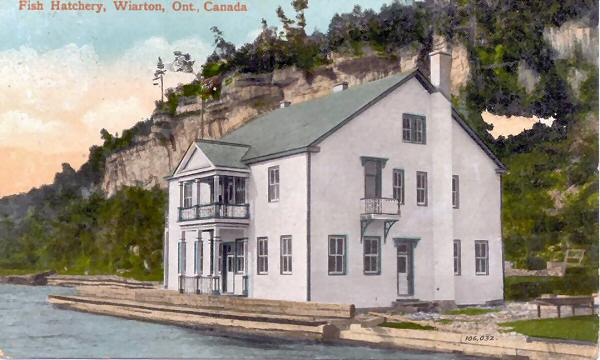
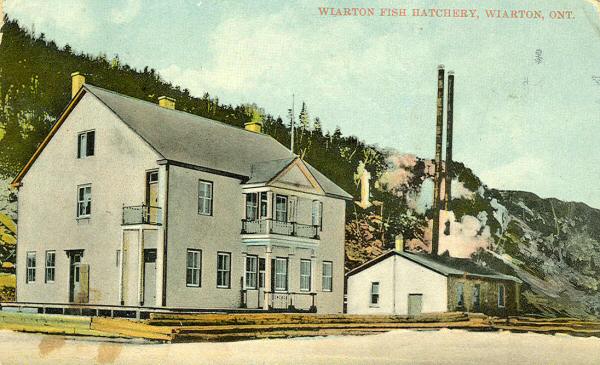
Figure
W13A: Two early views of the Wiarton Fish Hatchery (about 1910).
Figure W13A shows two images of the fish hatchery in its infancy (Note Spirit Rock to the left in the top image and the pumphouse to the right in the bottom image). Standing 45 by 50 feet at the aforementioned height of 2.5 storeys, the hatchery was flanked by cribwork and a dock on the shore of Colpoys bay. The Wiarton pumphouse, next door to the east, provided water to the 54 fish fry troughs on the main floor of the hatchery. These troughs were designed to hatch 4.5 million fish eggs per year. The upstairs of the hatchery served as the dwelling for the hatchery manager complete with four bedrooms, a kitchen, dining room, parlour and even a balcony.
During that first winter, a series of violet storms kicked up sand that entered the hatchery and killed hundreds of thousands of eggs. The cribwork along the shore was also pulled three feet out into the bay, leaving the waves only two feet from the hatchery. Despite these setbacks, the first fish fry were taken from the hatchery in late April of 1908 and distributed by tugboat off the shores of the islands at the mouth of Colpoy's Bay. During that first season the hatchery reaped a total harvest of 4.655 million salmon trout fry which were distributed among 18 different locations in Lake Huron and Georgian Bay.
Over the years, the hatchery strategically bred and released a large number and variety of fish, including species of trout and splake. Even in the years following the local introduction of the lamprey eel (via the Welland Canal around 1932 - see the Wiarton Fish House page for more details), the hatchery served a vital role in the losing battle to maintain the area's trout stock and once bustling fishing trade.
Millions of fish were spawned and released from the Wiarton hatchery over the years. This practice continued until 1992 when the town replaced the building with a new water filtration plant. After eight and a half decades, the white frame structure was dismantled. Large slabs of limestone were then dumped along the shoreline of the surrounding grounds to help guard against erosion. In 1993 the new architecturally plain (though no doubt useful) filtration plant was erected just east of the hatchery's former location. The last working vestige of the town's fishing industry, which had once been vital to the area (not to mention all of Ontario) was gone.
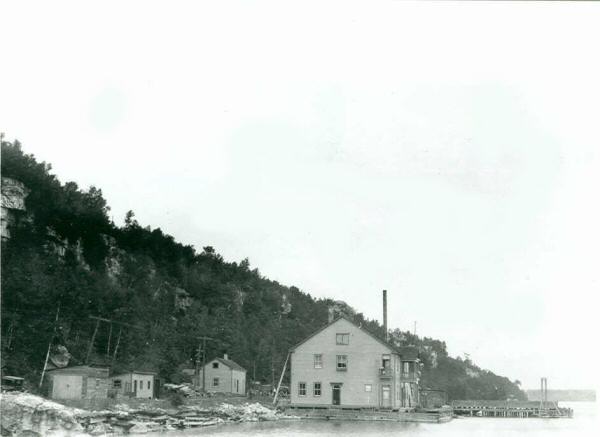
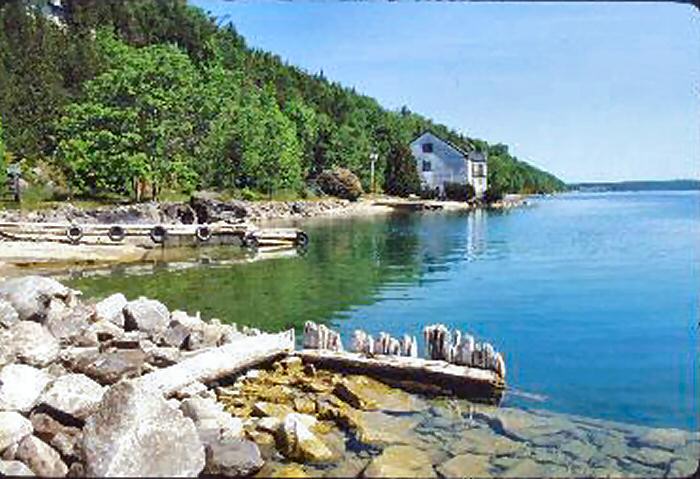
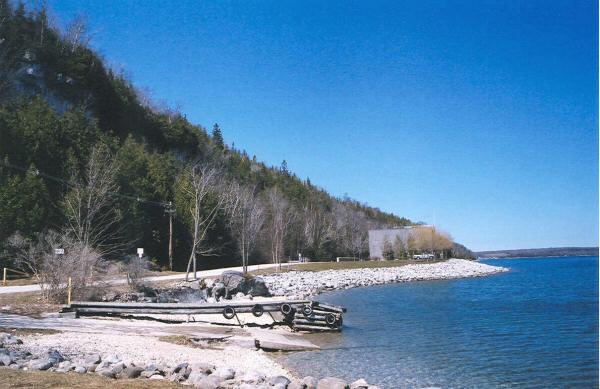
Figure W13B: Wiarton Fish Hatchery (about 1924 and 1990) and a similar view of the water plant in 2004.
Figure W13B shows three views of the fish hatchery location from nearly the same perspective. The top image, taken in 1924, shows the hatchery in its prime. The building looks practically unchanged in the middle image taken some 65 years later around 1990. However, the end was soon to come. The bottom image of Figure W13B shows the current water filtration plant in place of the hatchery that a young town had so strongly lobbied for some 100 years earlier.
The essence of the Wiarton Fish Hatchery lives on, however, through the efforts of private organizations such as the Bruce Peninsula Sportsmen's Association who, each spring, release hundreds of pounds of Rainbow Trout fry at the most popular spawing points of Colpoy's Bay. The process is, however, somewhat more labour-intensive than was the old fish hatchery. The fish are now transported by truck and then moved across the land and into the water by way of a hand-to-hand bucket line (see Figure W13C below).
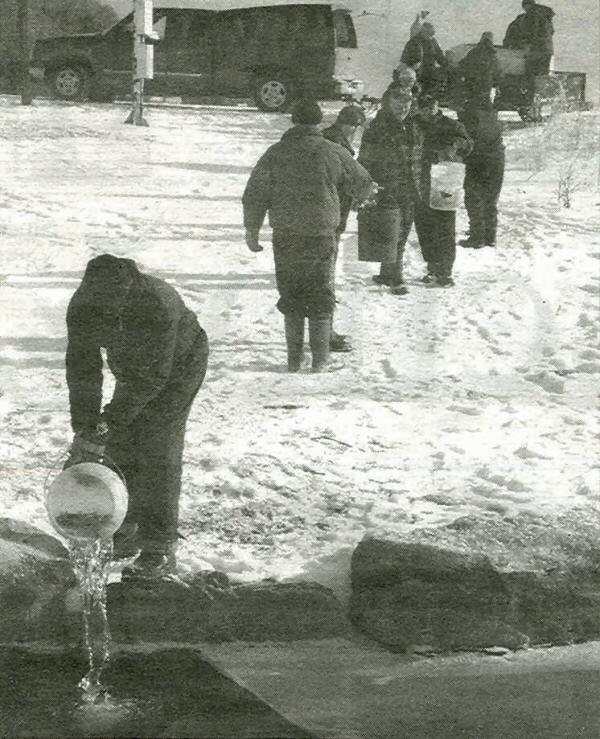
Figure W13C: The Bruce Peninsula Sportsmen's Association's annual fish fry release (c. 2005).

